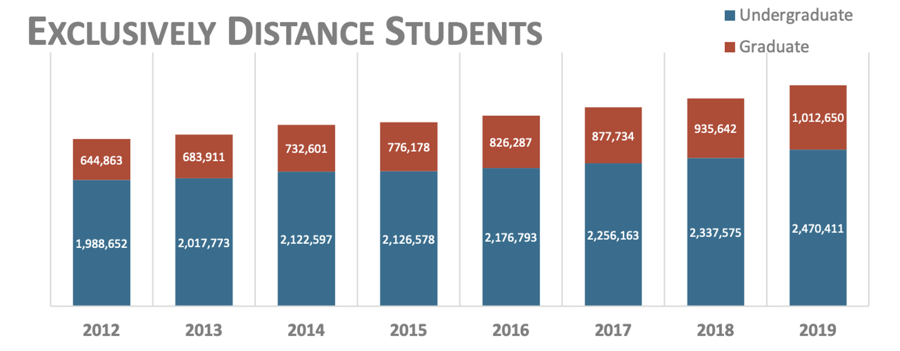Online Learning in Higher Education After COVID-19

By Former Chmura Staff |
In March 2020, the COVID-19 pandemic transformed the U.S. higher education system overnight. In-person instruction was replaced by virtual classrooms and pencil and paper substituted with computers. However, with the arrival and early success of vaccines, the possibility of returning to in-person instruction has become a reality for the fall 2021 semester and beyond, leaving school administrators with big decisions to make. While students and faculty may be eager to return to the physical classroom, many aspects of online education have provided benefits to the existing education system and may be here to stay. Different types of institutions may approach the 2021-2022 school year and the continued use of online education differently.
The digitization of higher education was occurring well before the pandemic, but the trend accelerated in 2020 as almost all courses moved online. By 2019, 37.2% of students took at least one distance education course and 77.3% of institutions offered some type of distance learning.[1] Public and private non-profit institutions were experiencing the fastest growth in distance learning, although most enrollments remained highly concentrated in a small percentage of schools.[2] Before the pandemic began, only 12% of four-year public college students took their courses entirely online.[3] However in March 2020, the COVID-19 pandemic forced the closure of over 1,000 colleges and universities, impacting over 14 million students and prompting a rapid transition to an entirely virtual education for most students.[4]

Source: https://www.bayviewanalytics.com/reports/almanac/national_almanac2019.pdf
Public and Private Non-Profit 4-Year Institutions
Most public and private non-profit 4-year institutions are eager to return to normal in the fall, with in-person classes and open libraries, gyms, and dining halls, to provide students with the traditional residential college experience.[5] U.S. colleges and universities have suffered an estimated $183 billion in collective losses from a lack of typical campus activities and tuition, incentivizing a rapid return to normal.[6] The arrival of COVID-19 vaccines has presented an opportunity for institutions to return to the pre-pandemic residential academic experience; however, public and private non-profit institutions may not revert completely.
A survey of over 100 four-year college and university presidents found that 44% planned to keep more than a quarter of classes online after the pandemic.[7] Colleges may capitalize on the benefits that online learning and teaching can provide for specific courses, such as large intro-level lectures which are typically taught in a lecture hall and cover general information that does not change much from year to year.[8] Institutions will likely choose to keep smaller, discussion-based classes in-person, as well as office hours with professors which provide greater benefits to students when experienced in-person.[9] By adopting a more flexible or hybrid approach to instruction, institutions can cut costs for some courses while still preserving the face-to-face interactions that make the college experience distinct. Well-designed and correctly applied online learning tools can also help institutions widen access to courses and improve quality.[10]
Institutions are already exploring how to work digital modes of instruction into their existing residential college experience. Brown University, for example, has introduced the possibility of moving large, introductory courses online in the future and offering some courses online to the general public to increase accessibility to the school’s prestigious academics.[11] Brown is also looking into incorporating digital tools, such as Canvas, into both in-person and online courses that could lead to innovation and enhance student learning and faculty research.[12] These online learning tools centralize key information for students and teachers into a single app or website, allowing users to access lecture information, provide and receive feedback instantly, and facilitate course discussions from anywhere.[13]
Small, private colleges that were already struggling prior to the pandemic may not be able to recover the traditional in-person college experience as effectively as larger schools. Utilizing online learning alternatives may provide opportunities for those colleges to cut costs rather than closing. Struggling colleges can offer more online classes to cut down on management costs of maintaining physical campus buildings and, with fewer students on campus, can cut back on costly non-academic activities. Citing enrollment declines, economic setbacks, and the impact of the pandemic, Notre Dame de Namur University, a small, private Catholic university in Belmont, California, is opting to transition to a primarily graduate and online university to keep the school from closing, sacrificing the in-person undergraduate program.[14] Other small schools facing similar financial struggles coming out of the pandemic will have to explore similar ways to keep their doors open, or face the possibility of closure.[15]
Community Colleges
Community colleges have suffered the steepest enrollment drops during the pandemic, contradicting trends in previous recessions.[16] Community colleges typically see increases in enrollment during recessions as students turn to education when there are fewer jobs. However, during the pandemic and simultaneous recession, community college enrollment has decreased, possibly due to the prediction that the recession would be short or the worry that the technical courses would not transfer well to an online format.[17] After the pandemic, community colleges can expand online program options to attract students, while utilizing physical spaces primarily for laboratories and training for technical skills to recover pandemic-induced financial losses. While the technical training programs offered by many community colleges require in-person instruction, lecture-based courses can be offered mostly or entirely online, presenting cost-saving opportunities for community colleges. By continuing to offer online options for some courses, community colleges can attract students who value the time and location flexibility of online education.[18] The average community college student is 28 years old, meaning they often have to fit in their education around other commitments such as work and family which makes the flexibility that online education can provide even more appealing.[19]
Some community colleges have taken early steps to adapt to this trend. Northern Essex Community College in Massachusetts opened course registration for the fall 2021 semester with 25% of courses offered in-person compared to the pre-pandemic level of around 85%, with the option to increase the number of in-person courses if demand was high enough.[20] However, administrators have found that even with a limited number of classes offered in-person, those courses have not been filled, suggesting that many students are content learning online.[21] The President of Northern Essex expressed doubt that the number of online classes would ever drop to its pre-pandemic level of 15%, citing the benefits of an online or hybrid schedule for students, their families, and their work lives.[22]
For-Profits
For-profit higher education institutions were well-positioned to weather the pandemic, as many for-profit institutions already provided a primarily online education. That preparation contributed to a 3% increase in undergraduate enrollment, even as other higher education institutions struggled.[23] Before the pandemic, 72% of students at four-year for-profits were learning completely online, meaning the pandemic would have little to no immediate impact on the learning experience or quality of education for those students.[24] Most four-year for-profit institutions had better online infrastructure to support a large number of students learning remotely, professors were already equipped to teach students from a distance, and many for-profits had existing reputations as providers of online education.[25] For students who did not want to pay full tuition to study remotely at a public or private non-profit institution, for-profits with established online programs provided a viable alternative.[26] For-profits will likely not see continued enrollment growth as high as during the pandemic, but enrollment may remain above pre-pandemic levels if students continue to demand the perks of time and location flexibility that online education offers.[27] In the short run, for-profits with established online programs can continue to use their advantages over less prepared schools to attract students who wish to study online.
Conclusion
The COVID-19 pandemic disrupted all aspects of higher education, revealing who was better prepared and who was not. Looking forward, investing in technology and expanding online learning capabilities will be necessary at all institutions to provide students with the educational skills and credentials that employers demand, while allowing for greater flexibility that benefits both students and professors. Although the digitization of higher education has lagged behind other industries, the pandemic has quickly revealed that providing a quality online education is not only feasible, but preferable for many institutions and students.[28] The digital transformation of higher education will affect all types of institutions and each school should explore how to incorporate the benefits online education into their programs while preserving the necessary in-person components that contribute to a productive learning environment.
Read more about the impact of colleges reopening in our related blog.
[1] https://www.bayviewanalytics.com/reports/almanac/national_almanac2019.pdf
[2] https://www.babson.edu/about/news-events/babson-announcements/babson-survey-research-group-tracking-distance-education-report/
[3] https://www.brookings.edu/blog/brown-center-chalkboard/2020/11/02/the-alarming-rise-in-for-profit-college-enrollment/
[4] https://www.cnbc.com/2020/03/26/how-coronavirus-changed-college-for-over-14-million-students.html
[5] https://www.insidehighered.com/news/2021/04/22/community-colleges-keeping-more-classes-online
[6] https://www.insidehighered.com/quicktakes/2021/02/09/colleges-could-lose-183-billion-during-pandemic
[7] https://www.insidehighered.com/views/2021/06/02/colleges-shouldnt-expect-their-employees-work-same-ways-they-did-pandemic-opinion
[8] https://www.cato.org/pandemics-policy/higher-education-after-covid-19#online-academic-instruction
[9] https://www.insidehighered.com/views/2021/06/02/colleges-shouldnt-expect-their-employees-work-same-ways-they-did-pandemic-opinion
[10] https://encoura.org/higher-education-predictions-for-2021-part-2/
[11] https://www.browndailyherald.com/2021/06/07/future-online-learning-brown/
[12] https://www.browndailyherald.com/2021/06/07/future-online-learning-brown/
[13] https://www.instructure.com/product/higher-education/canvas-lms
[14] https://www.insidehighered.com/news/2021/08/04/live-updates-latest-news-coronavirus-and-higher-education
[15] https://www.insidehighered.com/news/2020/03/30/‘it-would-take-something-major’-keep-doors-open-notre-dame-de-namur
[16] https://nscresearchcenter.org/stay-informed/
[17] https://www.nytimes.com/2021/04/02/us/politics/covid-19-colleges.html
[18] https://www.insidehighered.com/news/2021/04/22/community-colleges-keeping-more-classes-online
[19] https://www.nytimes.com/2021/04/02/us/politics/covid-19-colleges.html
[20] https://www.insidehighered.com/news/2021/04/22/community-colleges-keeping-more-classes-online
[21] https://www.insidehighered.com/news/2021/04/22/community-colleges-keeping-more-classes-online
[22] https://www.insidehighered.com/news/2021/04/22/community-colleges-keeping-more-classes-online
[23] https://www.brookings.edu/blog/brown-center-chalkboard/2020/11/02/the-alarming-rise-in-for-profit-college-enrollment/
[24] https://www.brookings.edu/blog/brown-center-chalkboard/2020/11/02/the-alarming-rise-in-for-profit-college-enrollment/
[25] https://www.forbes.com/sites/andrewdepietro/2020/11/19/investing-in-for-profit-schools-in-the-age-of-covid-19/?sh=1b6a4892713c
[26] https://qz.com/1934452/why-for-profit-college-enrollment-has-increased-during-covid-19/
[27] https://encoura.org/higher-education-predictions-for-2021-part-2/
[28] https://hbr.org/2020/09/the-pandemic-pushed-universities-online-the-change-was-long-overdue
Subscribe to the Weekly Economic Update
Subscribe to the Weekly Economic Update and get news delivered straight to your inbox.











